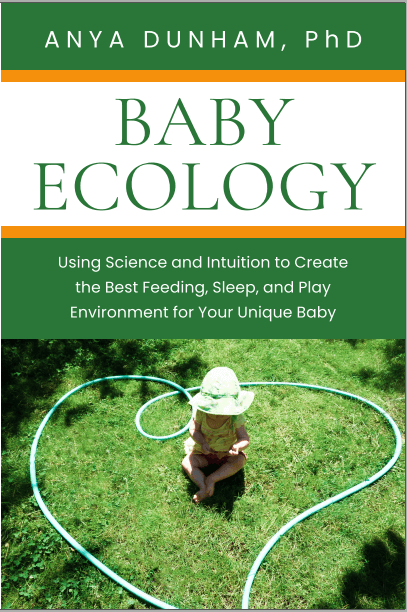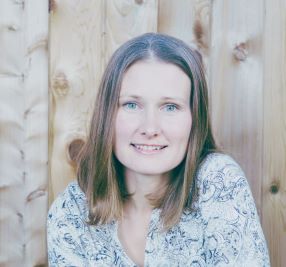Baby Ecology book is here! Learn more
Baby Ecology book is here!
Can babies get bored?
by Anya Dunham, PhD
Can babies get bored? What, if anything, do they need to avoid boredom? Let's see what the research says.
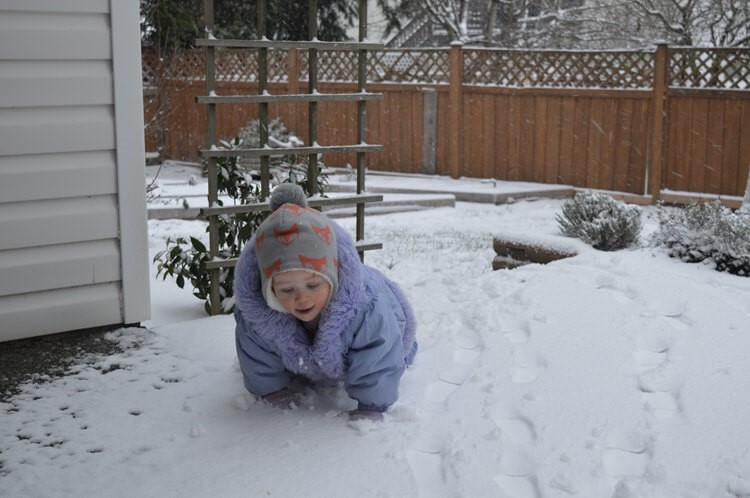
Does your baby seem easily bored, making you feel like you need to do a complete overhaul of the play area, purchase new toys, or sign your baby up for classes and activities? The thing is, what we think of as boredom could be something else entirely. Let's explore this a bit.
What is boredom?
Boredom is a feeling that most adults don't particularly enjoy. It has been defined as 'being dissatisfied by iteration or dullness' and feeling: (1) unspecific longing; (2) a disinterest in action, weariness; (3) a passive expectant attitude that the external world will provide gratification; (4) a feeling that time stops or is moving very slowly; and (5) the absence of fantasy.1 It has also been described as 'wanting but being unable to engage in a satisfactory activity'.2 Boredom arises under conditions that are under-stimulating or perceived as meaningless.3
Can babies get bored?
Boredom in adulthood is usually felt as a mood; it can also be something that tends to persist and resurface frequently in a person's life ('trait boredom').4,5 But when you think about your baby and the times they may have looked bored, there is a good chance it didn't look like a mood and didn't persist. Did it look like baby flitting from one activity to another? A quick burst of dissatisfaction? Or maybe a bid for your attention?
Boredom in babies is often more of a 'call to action':6 a sign that they are ready for some sort of change.
Boredom as a catalyst for learning
Babies are very self-motivated explorers who are always testing theories and working out patterns in the world around them. Like scientists, babies place the events they've repeatedly observed into categories, and then they use these categories to predict the outcomes of future events. For example, by about 5 months a baby usually learns that when she drops something, it falls down.7 It will take her years to label this as gravity, but she’s discovered a pattern about her physical surroundings. The next time she sees something fall, she is not surprised: her brain tags this predicted experience as “usual,” integrates it into existing knowledge, and stops paying attention to it. But when her experience is unusual — for example, she sees a helium balloon float in the air! — she cannot easily fit this observation into her existing knowledge, and her brain pays special attention.8
In other words, the balance between the familiar and the new helps babies learn. Babies use a "Goldilocks" strategy to optimize their learning: they avoid spending time examining stimuli that are too simple (highly predictable) or too complex (highly unexpected).9
So, can babies get bored? Yes, at least in the I-am-disinterested-in-the-familiar sense. But such boredom can actually be beneficial for babies' development: it motivates them to explore their environment more and to look for new experiences.
🎬Try this: When your baby seems disinterested in an activity or object, try doing nothing and just observing keenly and quietly. Your baby might find a toy to play with or an image, pattern, or movement to observe. Momentarily feeling bored helps your baby re-direct their attention to something that aids their learning. Whether your baby chooses to explore a play object or a pattern deeply or has many fleeting, brief interactions with various play objects10, they are likely learning exactly what they need from free play. Observing quietly, without feeling the pressure to immediately jump in and "rescue" your baby from boredom, might help you learn something new about your little person: what interests them, what may be hard for them, what they are working on.
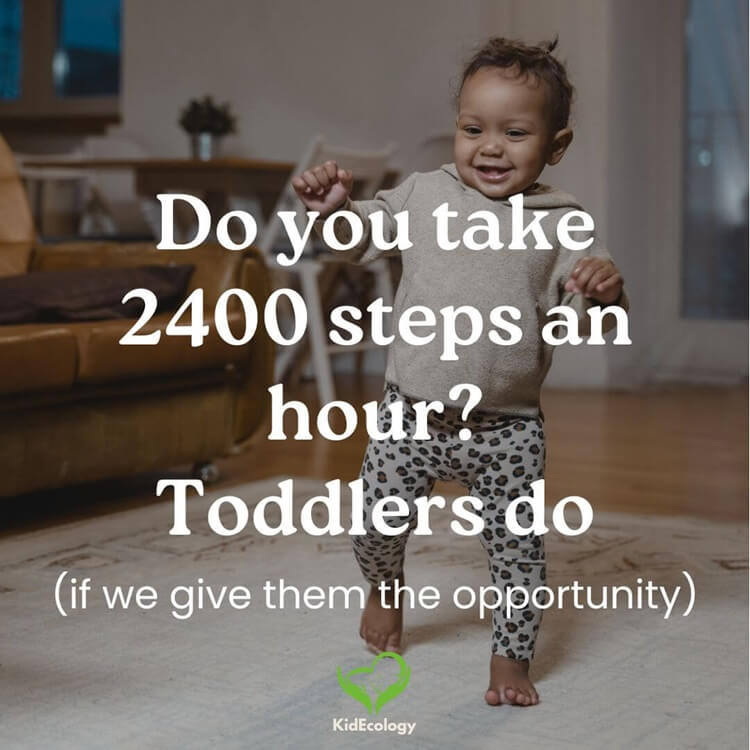
Did you know that during just one hour of free exploration, newly walking toddlers average 2400 steps, travel the distance of 8 American football fields, and visit most of available area and surfaces?11 Our babies and toddlers truly are self-motivated explorers.
🎬 Try this: If your baby is discontent while being confined to a container like a baby seat, swing, or high chair, they might be looking for more space to move around in and explore.
What we perceive as boredom might also be something else entirely
OK, you might say, but what if my baby isn't actively looking for something new, but instead appears a little listless, withdrawn, or disinterested? Do these signs indicate boredom?
Psychoanalyst and pediatrician Margaret Mahler called this babies and toddlers being 'a bit low-keyed'. There could be several reasons for that:
- Baby might be under the weather or tired
- Baby might be overwhelmed by sensory input
- Baby might be looking for connection with you
If we mistake these for boredom and offer the baby more toys, activities, or distractions, the baby can easily become even more tired, overwhelmed, and overstimulated.
🎬 Try this: When your baby looks 'low keyed', take a minute to pause, connect with your baby, and observe them quietly to see what they need. They might be ready for a break or a nap.
Spaces and play objects that grow with your baby
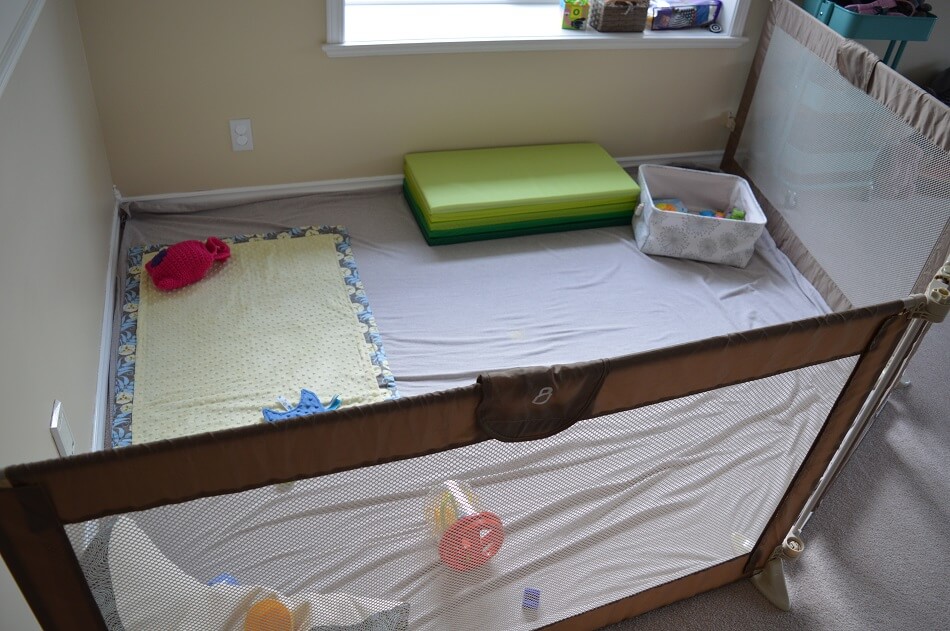
What about play spaces? Do babies get bored in the same space easily?
Creating a dedicated, safely gated play area when our kids were babies and toddlers made early parenting years much easier and much more enjoyable for my family. I learned this idea from the infant specialist and RIE® founder Magda Gerber. (Janet Lansbury calls such areas "yes spaces" and offers some great examples here.)
I tweaked our play area as our babies grew and their interests changed, but I didn't do any dramatic adjustments or overhauls. Spaces and toys of yesterday can offer babies new opportunities today if we let them explore freely to find new properties of these spaces and play objects and the new ways to use them.
Take a look at the photo of our play area above. This was our setup when our middle daughter was about 9 months old.
- The window ledge started off as a spot for my baby to focus her eyes on. As she grew, she began pulling up and cruising along it. Then, she started pushing objects off and putting them back on, experimenting with gravity, weights, textures, and sounds. And later on, she began arranging objects on the ledge, making small worlds out of megablocks and toy animals.
- The cloth basket was originally an object to shift and rock; then, something to flip over, testing balance and support; later yet, something to put toys into testing what fits, as well as climbing in and out of to see who fits 😊
- The green Ikea gym mat offered a surface that felt different (smooth); later, it became something to safely crawl onto and off, testing different ways to master an incline: feet first or head first?
- The plastic cups started off as objects to hold and mouth, and were later pushed, stacked, filled and emptied, talked into, balanced, and attempted to be worn as little hats 😊 The simplest toys – balls, buckets, cups – can have more educational value than toys marketed as STEM because they offer almost endless possibilities for open-ended, free play.
🎬 Try this: If you haven't already, consider creating a gated play area in your home. Such play area will give your baby opportunities to explore what interests them most without being interrupted and re-directed; freedom to move as much as they want to; and a chance to pause and rest when needed, adjusting their level of stimulation on their own. That's empowering, especially when you're little.
What are your thoughts on babies and boredom? Let me know here or on IG.
References
References
1. Greenson RR (1953) On boredom. Journal of the American Psychoanalytic Association 1: 7–21
2. Mercer-Lynn KB, Bar RJ, Eastwood JD (2014) Causes of boredom: The person, the situation, or both?Personality and Individual Differences 56: 122–126
3. Westgate EC, Wilson TD (2018) Boring thoughts and bored minds: The MAC model of boredom and cognitive engagement. Psychol Rev 125(5): 689-713
4. Anderson AJ, Perone S (2024a) The kids are bored: Trait boredom in early childhood and links to self-regulation, coping strategies, and parent–child interactions. Journal of Experimental Child Psychology 243: 105919
5. Anderson AJ, Perone S (2024b) How did we get so bored? A bioecological model of the development of boredom. Psychological Reports https://doi.org/10.1177/00332941241275590
6. Danckert J, Elpidorou A (2023) In search of boredom: Beyond a functional account. Trends in Cognitive Sciences 27(5): 494–507
7. Needham A, Baillargeon R (1993) Intuitions about support in 4.5-month-old infants. Cognition 47(2): 121-148
8. Cantor P et al (2019) Malleability, plasticity, and individuality: how children learn and develop in context. Applied Developmental Science 24(3): 307-337
9. Kidd C, Piantadosi ST, Aslin RN (2012) The Goldilocks Effect: Human infants allocate attention to visual sequences that are neither too simple nor too complex. PLoS ONE 7(5): e36399
10. Herzberg O, Fletcher KK, Schatz JL, Adolph KE, Tamis-LeMonda CS (2022) Infant exuberant object play at home: Immense amounts of time-distributed, variable practice. Child Development 93(1): 150-164
11. Adolph KE et al (2012) How do you learn to walk? Thousands of steps and dozens of falls per day. Psychol Sci 23(11): 1387-1394
Using hundreds of scientific studies, Baby Ecology connects the dots to help you create the best environment for sleep, feeding, care, and play for your baby.
Warmly,
Anya



